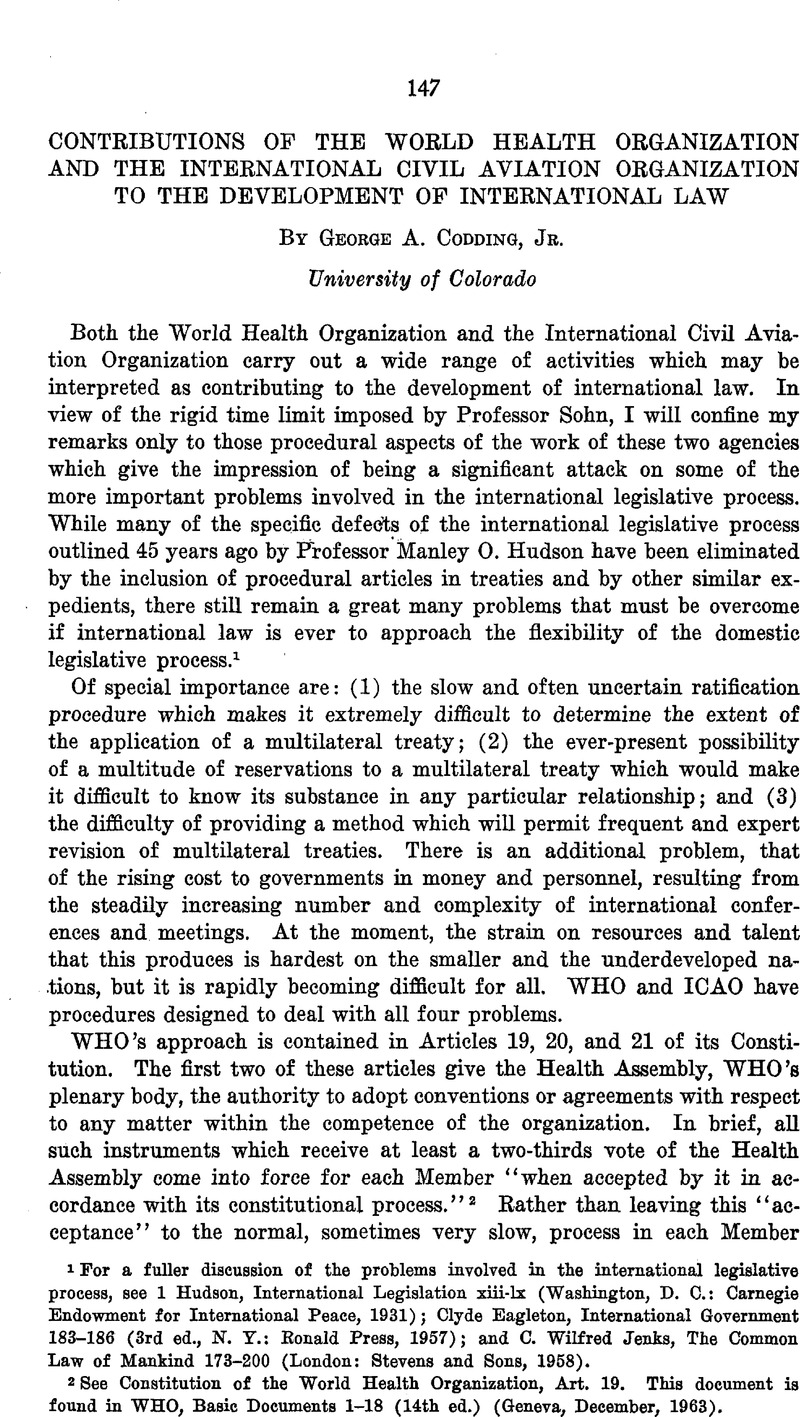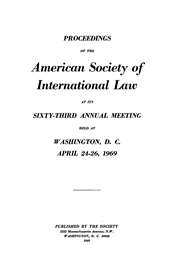No CrossRef data available.
Article contents
Contributions of the World Health Organization and the International Civil Aviation Organization to the Development of International Law
Published online by Cambridge University Press: 27 February 2017
Abstract

- Type
- Third Session
- Information
- Proceedings of the American Society of International Law at its annual meeting (1921-1969) , Volume 59 , 1965 , pp. 147 - 153
- Copyright
- Copyright © American Society of International Law 1965
References
1 For a fuller discussion of the problems involved in the international legislative process, see 1 Hudson, International Legislation xiii-lx (Washington, B. C: Carnegie Endowment for International Peace, 1931); Clyde Bagleton, International Government 183-186 (3rd ed., N. T.: Eonald Press, 1957); and C. Wilfred Jenks, The Common Law of Mankind 173-200 (London: Stevens and Sons, 1958).
2 See Constitution of the World Health Organization, Art. 19. This document is found in WHO, Basic Documents 1-18 (14th ed.) (Geneva, December, 1963).
3 If a Member does not accept the convention or agreement within the specified time limit, it must furnish the Director General with a statement of the reasons for nonacceptance. WHO has not yet used Arts. 19 and 20.
4 Art. 22.
5 See, for instance, International Sanitary Regulations (2nd annotated ed., Geneva, 1961).
6 States would remain bound, however, to the earlier sanitary conventions to which they were a party. See “The International Sanitary Eegulations (WHO Regulations, No. 2 ) , ” 10 Chronicle of the World Health Organization, 315 (Nos. 9-10, Spec. No.).
7 WHO, The First Ten Years of the World Health Organization 260 (Geneva, 1958).
8 The following areas are included: (1) communications systems and air navigation aids, including ground marking; (2) characteristics of airports and landing areas; (3) rules of the air and air traffic control practices; (4) licensing of operating and mechanical personnel; (5) airworthiness of aircraft; (6) registration and identification of aircraft; (7) collection and exchange of meteorological information; (8) log books; (9) aeronautical maps and charts; (10) customs and immigration procedures; (11) aircraft in distress and investigation of accidents; and (12) such other matters concerned with the safety, regularity, and efficiency of air navigation as may from time to time appear appropriate. See ICAO, Convention on International Civil Aviation 20-21 (3rd ed., Montreal, 1963).
9 See ICAO, International Standards and Eecommended Practices, Personnel Licensing, Annex 1, p. 3 (5th ed., Montreal, November, 1962). io in 1963 the Council was made up of the following countries: Argentina, Australia, Belgium, Brazil, Canada, Colombia, Congo (Brazzaville), West Germany, Prance, India, Indonesia, Italy, Japan, Lebanon, Malagasy Eepublic, Mexico, Netherlands, Nicaragua, Nigeria, Norway, Philippines, South Africa, Spain, Tunisia, United Arab Eepublic, United Kingdom, and United States.
10 Art. 90.
11 The manner in which each annex was created is summarized at the beginning of the official text. See, for instance, Annex 1, op. ait., p. 3. One of the best over-all discussions of the method by which the ICAO creates its annexes is to be found in E. H. Mankiewiez, “ L ‘adoption des annexes a la convention de Chicago par le Conseil de 1'Organisation de 1'Aviation Civile Internationale,” Beitrage zum internationalen Luftrecht. Festschrift zu Ehren von Prof. Dr. Jur. Alex Meyer 82-94 (Dusseldorf, 1954).
12 Art. 38. Further, aircraft or personnel not in compliance with international standards must have the particulars of such shortcomings endorsed on their respective certificates of airworthiness or licenses. Aircraft whose certificates are so endorsed, and personnel whose licenses are so endorsed, are permitted to participate in international air navigation only with the express permission of the states whose territory is entered. Arts. 39 and 40.
13 Mankiewiez, loc. cit. 87, especially note 22.
14 Art. 54 (m).
15 ICAO, International Standards, Eules of the Air, Annex 2, p. 5 (4th ed., Montreal, May, 1960).
16 See Personnel Licensing, Annex 1, op. cit., p. 3 j and ICAO, International Standards and Eeeommended Practices, Operation of Aircraft, Annex 6, p. 3 (5th ed., Montreal, October, 1957).
17 Modifications of the provisions of ICAN's Technical Eegulations demanded a threefourths approving vote of all states represented at the Commission's meeting and twothirds of the total possible vote which could be cast if all the state-members were represented. See U. S. State Department, International Convention Eelating to the Begulation of Aerial Navigation Dated October 13, 1919, with the Annexes to the Convention and Protocols of Proposed Amendments, pp. 9-10 (State Department Pub. 2143. Washington, D. C: U. S. Government Printing Office, 1944).
18 See Krzysztof Skubiszewski, “Forms of Participation of International Organizations in the Lawmaking Process,” 18 International Organization 800 (1964).
19 See George A. Codding, Jr., International Telecommunication Union 28 (Leiden: E. J . Brill, 1952).
20 See Traits eoncernant la creation d'une Union generate des postes (1874), Reglement de detail et d'ordre pour l'ex§cution du traite, Art. XXVII. This document can be found in UPU, Documents du Congres postal international, r6uni a Berne du 15 Septembre au 9 Octobre 1874, pp. 155-164 (Bern, 1875).
21 See UPU, Documents du Congres postal universel de Paris, 1878, p. 664 (Bern, 1879).
23 See George A. Codding, Jr., Universal Postal Union 107 (New York: New York University Press, 1964).
24 Jenks, op. oit. 187.


